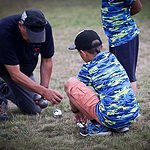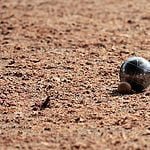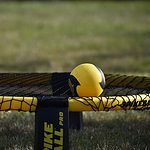If you've ever found yourself yearning for a backyard retreat akin to a hidden gem in a bustling city, building a bocce ball court could be your oasis. The allure of the smooth green surface, the satisfying thud of the ball against the target, and the camaraderie it fosters are all within reach.
But where do you start? Let's explore the essential steps to create your own backyard bocce ball court, from selecting the right location to adding the final touches that will make your court a favorite gathering spot for family and friends.
Key Takeaways
- Establish court dimensions and boundaries accurately with wooden stakes and pressure-treated posts.
- Enhance drainage with a French drain and layers for stability and water management.
- Use quality materials like pressure-treated boards and crushed stone for a durable court.
- Pay attention to layout details for regulation standards to optimize gameplay experience.
Establish Court Dimensions and Set Posts
To begin creating your backyard bocce ball court, carefully determine the standard dimensions of 13×91 ft. This ensures that your court adheres to the traditional measurements, with a width to length ratio falling between 1:5 and 1:7.
Once you have these dimensions set, it's time to mark out the boundaries with wooden stakes. Drive these stakes securely at each corner of the court to provide a clear outline for where the playing area will be.
The wooden stakes serve as guides for the court posts, which will help maintain the structure of the playing area. Use pressure-treated 4×4 posts to establish the corners of your bocce court firmly. When setting up these posts, make sure they're positioned at the correct distance to uphold the specified dimensions. Measure and adjust as necessary to fit the available space and desired size of your court. This meticulous attention to detail in setting up the posts ensures a sturdy foundation for your bocce ball court.
Add Optional French Drain
Prevent water accumulation and maintain proper drainage on your bocce ball court by adding an optional French drain. Here's how you can enhance the drainage system for your court:
- Install a French Drain: Lay corrugated drain pipe along the court to prevent water buildup and ensure proper drainage.
- Digging: Prepare the area by digging a spot in the center of the court where the French drain will be placed to facilitate water flow away from the playing surface.
- Add Extra Pipe: Consider adding extra pipe to the French drain system to improve its efficiency in removing excess water and preventing any potential waterlogging issues.
Build Frame
Consider starting the frame construction by selecting pressure-treated 4×4 boards to ensure a durable and stable foundation for your backyard bocce ball court. These boards are essential for creating a sturdy frame that will withstand the rigors of gameplay.
When building the frame, it's crucial to secure it firmly by sinking it slightly into the ground to enhance stability. Make sure the frame is level and square to maintain the proper dimensions of the court, ensuring an accurate playing surface.
To anchor the frame securely in place, consider using rebar or stakes driven into the ground at intervals along the frame's perimeter. This will help prevent any shifting or movement during use.
Install Gravel Layer
For a solid foundation that ensures proper drainage and stability for your backyard bocce ball court, the next step is to lay down a layer of gravel. The gravel layer serves as a crucial component for drainage, providing a stable surface for your bocce ball court.
Here's how to install the gravel layer effectively:
- Prepare the Area: Clear the designated area of any debris or vegetation to create a clean foundation for the gravel layer.
- Spread and Compact: Evenly spread a layer of large gravel over the cleared area. Use a tamper to compact the gravel firmly, ensuring a solid and stable base for the court.
- Level the Surface: After compacting the gravel, use a level to ensure an even surface across the entire area. A level gravel layer is essential for the proper installation of the bocce ball court and will contribute to its longevity and functionality.
Install Crushed Layer
To create a stable and level surface for your backyard bocce ball court, shovel in a layer of large gravel for proper drainage. Once the gravel layer is in place, make sure to compact it evenly using a tamper. This step is crucial to ensure the stability of the court. Next, add a weed barrier over the gravel to prevent any unwanted weed growth that could disrupt your playing surface.
Now, it's time to focus on the crushed layer of your bocce court. Shovel in the decomposed granite to create a 2- to 3-inch layer that will serve as the foundation for your playing surface. This crushed layer is essential for providing a solid base for the court. Once the decomposed granite is in place, you can then finish off by adding a 2-inch top layer of either sand or crushed oyster shell. These materials will create the perfect playing surface for your bocce ball court, ensuring smooth gameplay for you and your friends or family.
Install Top Layer
When installing the top layer for your backyard bocce ball court, ensure the surface is meticulously leveled and evenly spread to guarantee a seamless playing experience. The top layer is crucial for the quality of play and overall aesthetics of the court.
Here's how to install the top layer effectively:
- Choose the Right Material: Select either sand or crushed oyster shell for your top layer based on personal preference and budget. Both materials offer a smooth playing surface when properly installed.
- Court Size Consideration: Adjust the quantity of the top layer material depending on the size of your bocce ball court. Larger courts may require more material to cover the entire area adequately.
- Use a Tamper: After spreading the top layer material evenly, use a tamper to compact it. This step ensures stability and durability, providing optimal playing conditions for you and your guests.
How to Maintain a Bocce Ball Court
Maintenance of your bocce ball court is essential to ensure a lasting, enjoyable playing experience for all. Regular maintenance tasks such as raking the playing surface to remove debris and using a roller to compact the surface materials will help maintain a smooth and consistent playing area. Consider adding a fresh layer of crushed oyster shells or sand periodically to keep the desired surface thickness. It's also important to apply a deck sealer every couple of years to protect the wooden borders from weathering and damage. Building and utilizing a screed tool can help ensure the layers of gravel, rock, or sand are leveled properly, providing an optimal gameplay experience.
| Maintenance Task | Description | Importance |
|---|---|---|
| Rake the playing surface | Remove debris and maintain a smooth playing area | High |
| Use a roller | Compact surface materials for a consistent playing experience | High |
| Add crushed oyster shells | Periodically add to maintain desired surface thickness | Medium |
| Apply deck sealer | Protect wooden borders from weathering and damage | High |
| Utilize a screed tool | Level layers of gravel, rock, or sand for optimal gameplay | Medium |
Mapping the Court Dimensions
Mapping out the dimensions of your bocce ball court involves setting clear boundaries and ensuring a well-defined playing area for an optimal gameplay experience. To achieve this, follow these steps:
- Drive Stakes at the Corners: Begin by marking the corners of your court with stakes. This will create a clear visual guide for the dimensions of your bocce ball court.
- Determine the Width and Length: Measure the width and length of your court according to regulation standards or your desired dimensions. A standard bocce ball court is typically 13 feet wide and 91 feet long, but adjustments can be made based on available space and personal preference.
- Create a Regulation Court: Ensure that the width to length ratio of your court falls between 1:5 and 1:7 to meet regulation standards. Accurate measurement and mapping of the court dimensions will guarantee a well-defined and suitable playing surface for enjoyable bocce ball games in your backyard.
Creating the Court
Now that you have mapped out the dimensions of your bocce ball court, it's time to dive into creating the physical court itself, ensuring a solid foundation and optimal playing surface for your backyard games. To build the court, you will need to construct a sturdy wooden border, fill it with layers of crushed stone and gravel, and ensure the surface is level to prevent any disruptions during gameplay. Here is a breakdown of the materials you will need:
| Materials | Description | Purpose |
|---|---|---|
| Pressure-treated 4×4 boards | Durable wood for framing the edges of the court | Build a sturdy wooden border |
| Crushed stone | Provides stability and a solid base layer | Create a stable foundation |
| Processed oyster shells or sand | Top layer for the court | Smooth playing surface |
Ensure the wooden border is level and accurately calculate the materials needed. Consider the weather conditions when choosing the top layer material. By following these steps, you will be on your way to enjoying many fun-filled games of bocce in your backyard.
Lay Out the Court
Mark the corners and layout of your bocce court accurately using measuring tape and stakes to ensure precise dimensions for optimal gameplay. When building a bocce court in your backyard, it's essential to pay close attention to the layout to create a space that meets regulation standards and enhances the playing experience.
Here are some key steps to help you with the layout:
- Measure Twice, Mark Once: Use a measuring tape to mark out the exact dimensions of the court. Ensure it's 13 feet wide and 91 feet long for the best gameplay experience.
- Center Line and Foul Lines: Measure and mark the center line running across the court's length. Additionally, mark the foul lines on each side to determine valid playing areas.
- Maintain Proper Ratios: Consider the width to length ratio when setting up your court. Aim for a ratio between 1:5 to 1:7 to ensure the court's dimensions align with standard bocce regulations.





